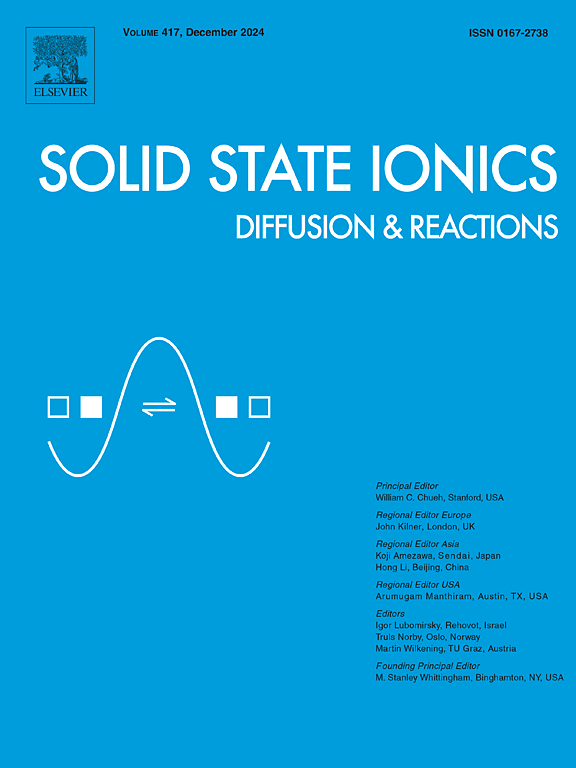晶体与非晶态Li4PS4I:结构对固态电池离子传输和性能的影响
IF 3
4区 材料科学
Q3 CHEMISTRY, PHYSICAL
引用次数: 0
摘要
全固态电池(assb)由于其潜在的优势,包括增强的安全性、更高的能量密度和更宽的工作温度范围,正在成为下一代储能解决方案。在各种固体电解质中,无定形和晶体Li4PS4I因其预测的高导电性和高耐湿性而引起了人们的兴趣。然而,实验研究报告了Li4PS4I的电导率值的广泛变化,在298 K下范围为0.03至3.5 mS.cm−1,明显低于理论预测。本文采用x射线衍射(XRD)、31P魔角自旋核磁共振(31P MAS NMR)和电阻抗谱(EIS)相结合的方法,证明了控制Li4PS4I的结晶度对其电化学性能起着至关重要的作用。对分布函数(PDF)分析揭示了Li4PS4I非晶态和晶体间局部原子排列的差异。此外,分析表明,机械铣削改变了PS4四面体和碘离子的局部环境,这可能解释了电导率的差异。此外,在阴极复合材料中加入非晶陶瓷Li4PS4I的assb与非晶Li4PS4I相比,表现出更强的循环稳定性。这些发现强调了调节结晶度作为优化assb离子传输特性和循环性能的有效方法的潜力,为固体电解质的进一步发展铺平了道路。本文章由计算机程序翻译,如有差异,请以英文原文为准。
Crystalline vs. amorphous Li4PS4I: Impact of structure on ionic transport and performances in solid-state battery
All-solid-state batteries (ASSBs) are emerging as next-generation energy storage solutions due to their potential advantages, including enhanced safety, higher energy density, and broader operational temperature ranges. Among various solid electrolytes, amorphous and crystalline Li4PS4I, have attracted interest due to their predicted high conductivity, and high moisture-tolerance. However, experimental studies have reported a wide variation in conductivity values for Li4PS4I, ranging from 0.03 to 3.5 mS.cm−1 at 298 K which are significantly lower than theoretical predictions. Herein, by employing a combination of X-ray diffraction (XRD), 31P magic-angle spinning nuclear magnetic resonance (31P MAS NMR), electrical impedance spectroscopy (EIS), we demonstrate that controlling the crystallinity of Li4PS4I plays a crucial role in its electrochemical performance. Pair distribution function (PDF) analysis reveals the differences in local atomic arrangements between amorphous and crystalline Li4PS4I. Additionally, the analysis indicates that mechanical milling alters the local environment of PS4 tetrahedra and iodide anions, which may explain the discrepancy in conductivity. Furthermore, ASSBs incorporating amorphous-ceramic Li4PS4I in the cathode composite exhibit enhanced cycling stability compared to amorphous Li4PS4I. These findings underscore the potential of tuning crystallinity as an effective approach to optimize the ionic transport properties and cycling performance of ASSBs, paving the way for further advancements in solid electrolytes.
求助全文
通过发布文献求助,成功后即可免费获取论文全文。
去求助
来源期刊

Solid State Ionics
物理-物理:凝聚态物理
CiteScore
6.10
自引率
3.10%
发文量
152
审稿时长
58 days
期刊介绍:
This interdisciplinary journal is devoted to the physics, chemistry and materials science of diffusion, mass transport, and reactivity of solids. The major part of each issue is devoted to articles on:
(i) physics and chemistry of defects in solids;
(ii) reactions in and on solids, e.g. intercalation, corrosion, oxidation, sintering;
(iii) ion transport measurements, mechanisms and theory;
(iv) solid state electrochemistry;
(v) ionically-electronically mixed conducting solids.
Related technological applications are also included, provided their characteristics are interpreted in terms of the basic solid state properties.
Review papers and relevant symposium proceedings are welcome.
 求助内容:
求助内容: 应助结果提醒方式:
应助结果提醒方式:


